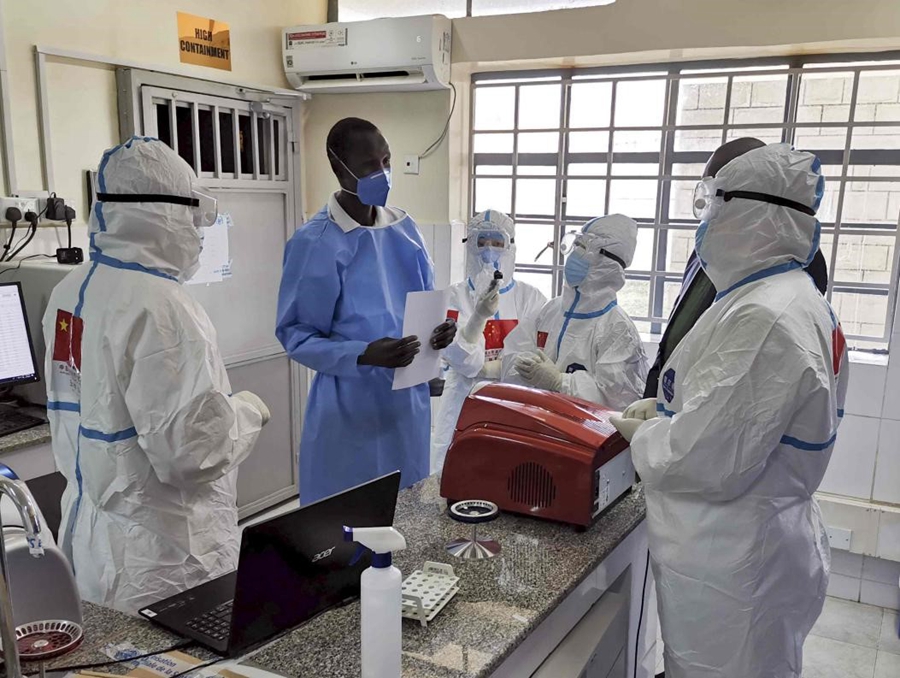Silk Road Community Building Initiative facilitates people-to-people exchanges among BRI countries (4)
 |
| Chinese doctors talk with medical workers in Juba, capital city of South Sudan, at a local COVID-19 nucleic acid testing institution, August 21, 2020. (File photo) |
Friendship, which derives from close contact between the people, holds the key to sound state-to-state relations. Since it was put forward in 2019, the Silk Road Community Building Initiative has facilitated non-governmental exchanges among countries participating in the Belt and Road Initiative (BRI), consolidated the friendship among peoples, and driven BRI countries to reach a broader consensus on building a community with a shared future for mankind.
Proposed by China NGO Network for International Exchanges (CNIE) at the second Belt and Road Forum for International Cooperation, the Initiative has by far promoted the establishment of nearly 600 pairs of cooperation partnerships between NGOs along the Belt and Road and the implementation of more than 300 livelihood cooperation projects covering various fields including health, education, science and technology, culture and community development.
Enkhotgon, a resident in Ulan Bator, capital city of Mongolia, is thrilled that his son, who suffered from congenital heart disease, got cured by Chinese doctors thanks to the Silk Road Community Building Initiative.
In May 2019, Chinese doctors came to Ulan Bator to implement congenital heart disease screening for children, during which Enkhotgon’s son, who was eight years old, was found eligible for operation. The boy then received free surgery in Wuxi, east China’s Jiangsu province, in December that year. “The trip to China proved to be a huge surprise,” said Enkhotgon.
“My son can now take P.E. classes with other kids, and often helps me with household chores. My husband and I don’t have to run around seeking medical advice on my son’s disease from one doctor after another. We are truly grateful to Chinese doctors for bringing health to our son,” said Otgongerel, Enkhotgon’s wife.
Since 2017, the Red Cross Society of China, together with Mongolian Red Cross Society (MRCS), Afghan Red Crescent Society and other institutions, has launched many missions under the humanitarian aid program for children suffering from major diseases in BRI countries, providing free medical treatment for several hundred children who are diagnosed with congenital heart disease in Mongolia and Afghanistan.
The program has benefited children in 21 Mongolian provinces, and brought a brand new life to many of them, according to Bolormaa Nordov, secretary general of the MRCS, who noted that China has also helped Mongolia with training sessions for medical personnel including ophthalmologists and first-aid trainers, improving the public health services in Mongolia.
In September 2019, the China Foundation for Poverty Alleviation initiated a vocational training program for impoverished young people in Nepal, helping over 200 Nepalese residents learn electrician and plumber skills.
Dilip, one of the trainees in the program, participated in home wiring and electricity maintenance as a community electrician amid efforts to prevent and control the COVID-19 pandemic.
“Because of the three-month-long intensive vocational training, I have not only learned electrician skills, but become more confident at work,” Dilip said, adding that the training program has equipped many young people in Nepal with vocational skills and helped them find jobs.
“We will continuously improve our skills and strive for greater career prospects,” the electrician noted.
“After a devastating earthquake in 2015, many buildings and roads in Nepal required reconstruction, and skilled labor was badly needed,” pointed out Rajan Kc, a member of the Constituent Assembly in Nepal.
Vocational training supported by China is helpful for improving the professional skills of local young people, which well meets the needs of Nepal, according to the Nepali politician, who added that relevant programs have helped many young people secure jobs near their home.
The Silk Road Community Building Initiative conforms to the needs of developing countries, said Dr. Tharakorn Wusatirakul, deputy director of “The Belt and Road” Cooperation Research Center in Thailand.
The fruitful cooperation projects on people’s livelihood under the Silk Road Community Building Initiative have been warmly welcomed by many countries, and made countries and regions along the BRI routes more determined to actively build the Belt and Road, he pointed out.
 |
Photos
Related Stories
- BRI signals new era in multilateral cooperation, says Cyprus House president
- China's Xiamen port registers 1,000 Silk Road Shipping voyages in 2021
- Belt and Road cooperation a path of hope for countries
- Sixth int'l "The Silk Road" conference held in Sofia
- Xi highlights vital role of BRI solidarity
- BRI opens new ways of trade and investment from China: Turkish businessman
- U.S. should not decry China for lending to BRI countries: media
- Multi-billion-USD investments inked at Silk Road int'l expo
- Silk Road int'l expo kicks off in China's Xi'an
- Senior CPC official calls for boosting B&R cultural exchanges
Copyright © 2021 People's Daily Online. All Rights Reserved.










